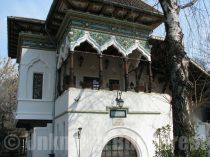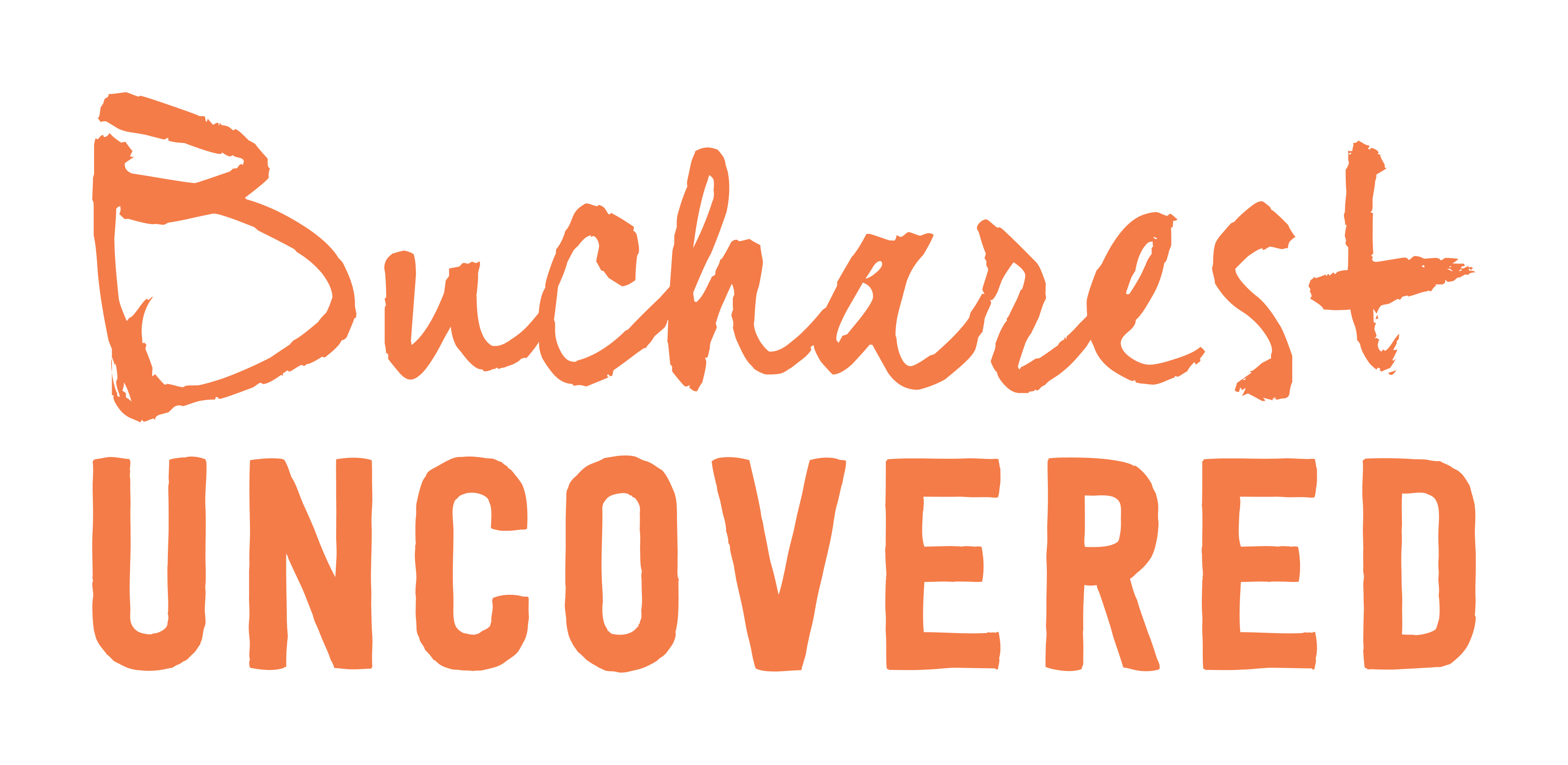Bucharest Top Landmarks
Take your time and browse through my Bucharest city tours to choose the one which suits you best!
Essential Bucharest Landmarks (23) • Top Bucharest Churches (11) • Museums (12)
► Essential Bucharest Landmarks (23)
…………………………………………………………………………………………………………………………………………………………………………….. 1. The Athenaeum (1888)
1. The Athenaeum (1888)
On one of the oldest and most representative artery which is Calea Victoriei, across the former Royal Palace, stands the Athenaeum, the celebrated symbol of the national culture, a prominent architectural and cultural heritage. As an institution dedicated to the “endowment of people with useful knowledge”, the Athenaeum Cultural Society had been founded as far back as 1865… READ MORE›
……………………………………………………………………………………………………………………………………………………………………………..  2. Hanul lui Manuc (1802)
2. Hanul lui Manuc (1802)
When in Bucharest, Hanul lui Manuc (Manuc’s Inn) should definitely be a top must see. Apart from its distinguishing appearance and uniqueness, Manuc’s Inn is one of the few remaining vestiges of Bucharest’s vanished caravansaries. Moreover, Hanul lui Manuc is a rare example of local vernacular architecture and a symbol of the patriarchal and Balkan city. READ MORE›
………………………………………………………………………………………………………………………………………………………..
 3. Stavropoleos Church (1724)
3. Stavropoleos Church (1724)
A jewel in the historical heart of the city, Stavropoleos Church is one of the most representative and outstanding examples of local late medieval art and architecture (Wallachian or ‘Brancovenesc’ style) and was one of the inspirational sources for the Romanian architect Ion Mincu, the creator of the National architectural style. Visitors are delighted by the rich carved stone decorations and colorful mural paintings. READ MORE›
………………………………………………………………………………………………………………………………………………………….
 4. The Central School (1892)
4. The Central School (1892)
Originally the “Princely Boarding School for Girls”, an elitist educational institution for young girls belonging to upper class society. The Central School is emblematic of the Neo-Romanian style, the Romanian national romantic architecture. Architect Ion Mincu who was commissioned the project provided through this outstanding, innovative and original work, a local expression of the Art Nouveau, using in a creative manner vernacular elements of Oriental influence, in the time of emergence of this movement in Europe. READ MORE›
…………………………………………………………………………………………………………………………………………………………..
 5. The Parliament Palace (1984-1990)
5. The Parliament Palace (1984-1990)
Known also as the House of the People is considered a major tourist attraction in today’s Bucharest, and indeed, visitors rarely miss the second largest administrative building in the world. It was conceived by the late communist dictator Nicolae Ceausescu as the seat and a symbol of his political power. READ MORE›
……………………………………………………………………………………………………………………………………………………………………………
 6. The Old Princely Court (15th century)
6. The Old Princely Court (15th century)
The Princely Court and its surroundings represent the original hearth of the city, around which Bucharest grew and developed. When Prince Vlad The Impaler and his court took residence on the banks of Dambovita River, this triggered a growth in population, attracting merchants and craftsmen who settled in large numbers in the area. READ MORE›
………………………………………………………………………………………………………………………………………………………………..
 7. The National Bank Palace (1890)
7. The National Bank Palace (1890)
In the context of the country’s national and political revival after the Unification of Principalities in 1859, the project of a National Bank became a first priority on the agenda. The chosen site was Serban Voda Inn, located in the core of the city, itself bearing a two centuries commercial tradition, but in an advanced state of decay at the time. The work was commissioned to renowned architects… READ MORE›
…………………………………………………………………………………………………………………………………………………………….
 8. Caru’ cu Bere (1899)
8. Caru’ cu Bere (1899)
The legendary beer hall was opened in the late 19th century by the Transylvanian-born Nicolae Mircea who previously had done his apprenticeship as a tavern-keeper in Bucharest. He traveled to Bavaria to get inspiration from the Bavarian beer houses and made a deal with the Romanian industrialist Dumitru Marinescu “Bragadiru”, who had opened a brewery just a few years earlier, to supply him with the beer. In quite a short time Caru’ cu Bere became popular for the good beer and for the famous Romanian “mititei” (sausage-shaped, spiced meatballs grilled over charcoals, typical to this country), being frequented by writers and actors of the time. READ MORE›
……………………………………………………………………………………………………………………………………………………………………
 9. The Savings Bank Palace (1900)
9. The Savings Bank Palace (1900)
The Deposit and Savings House is emblematic of the efforts of the political and economic elites to build the foundations of the public finances of the young Romanian state created after the Unification of 1859. The construction of a home worthy of its importance started in 1897, and King Carol I himself placed the cornerstone of the new building. The Savings Palace is an iconic building… READ MORE›
…………………………………………………………………………………………………………………………………………………………….
 10. The National Military Circle (The Officers’ Circle, 1910-1923)
10. The National Military Circle (The Officers’ Circle, 1910-1923)
Resembling the Opera Garnier in Paris, The National Military Circle Palace is one of the most beautiful and representative buildings in Bucharest. The edifice was built for the Officers’ Circle of the Bucharest military garrison, organization of the Romanian Army officers founded in 1876. The palace was famous for the glamorous balls… READ MORE›
……………………………………………………………………………………………………………………………………………………………………..
 11. Cismigiu Garden (1852)
11. Cismigiu Garden (1852)
A visit to Bucharest would not be complete without a stroll through the Cismigiu Garden, a favorite and much loved place for generations of city’s inhabitants. It could be said that the modernization of Bucharest started with Cismigiu. At the mid-19th century, the Austrian landscape architect Friedrich Meyer, former director of the Vienna Imperial Gardens, was asked to transform a swampy terrain into a public garden. READ MORE›
……………………………………………………………………………………………………………………………………………………………………….
 12. Capsa House (19th century)
12. Capsa House (19th century)
Founded in 1852, the legendary confectionery and coffee-house Capsa literally made history. At the height of its glory, it used to be a favorite meeting place of the high aristocracy and leading political figures, who used to have secret political talks at Capsa. The brothers Capsa’s pastry shop was already well-reputed in Bucharest when they decided, in 1868, to move to larger quarters… READ MORE›
……………………………………………………………………………………………………………………………………………………………………
 13. The Royal Palace (The National Art Museum, 1937)
13. The Royal Palace (The National Art Museum, 1937)
The actual edifice, dating from 1937, replaced a previous building, which was for decades the power center of the Romanian monarchy. At his arrival in the country, Prince Carol found on the spot a rather modest Princely residence. After Romania was proclaimed a Kingdom in 1881, the decision was made to extend the palace. READ MORE›
……………………………………………………………………………………………………………………………………………………………………….
 14. Carol I Royal Foundations
14. Carol I Royal Foundations
The statue of King Carol I stands proudly in the middle of the Palace Square, in front of a beautiful building bearing on the frontispiece the King’s name: “Fundatiunea Universitara Carol I”, “Carol I University Foundation”. Preoccupied with fostering the education at all levels, in 1891, with the occasion of 25 years of his reign, the King decided to create a library to be used by university students. READ MORE»
…………………………………………………………………………………………………………………………………………………………………………..
 15. Coltea Settlements (1888)
15. Coltea Settlements (1888)
The Sword Bearer Mihai Cantacuzino, great Christian and philanthropist, erected on this place between 1695-1698 a stone church, and then decided to establish around it a monastery, a belfry, a school and a hospital. It is worth noting that Mihai Cantacuzino is also the founder of the renowned Sinaia Monastery. The hospital was the first one in Wallachia, and has been functioning uninterruptedly ever since. READ MORE»
…………………………………………………………………………………………………………………………………………………………………….
 16. The Sutu Palace (1833)
16. The Sutu Palace (1833)
The Sutu Palace is among the oldest boyar palaces still standing in Bucharest. It belonged to the important Sutu family of Greek origins, who gave Princes to both Wallachia and Moldavia. In 1833 Costache Sutu started the construction of a house in front of Coltea Church, on a piece of land brought as dowry by his wife. He commissioned the work to two Viennese architects. READ MORE»
…………………………………………………………………………………………………………………………………………………………………………
 17. The University (central body 1857-1869, damaged during WWII and reconstructed afterwards; extended 1914-1934)
17. The University (central body 1857-1869, damaged during WWII and reconstructed afterwards; extended 1914-1934)
The University, the first modern educational institution in Bucharest, continues a tradition of education which goes back to the 17th century. In 1857, the foundation stone of the University was laid on the very place of St Sava College. That was the former Princely Academy St Sava, the oldest superior school in Bucharest. READ MORE»
………………………………………………………………………………………………………………………………………………………………………….
 18. The monument of Mihai Viteazul (Michael the Brave, 1876)
18. The monument of Mihai Viteazul (Michael the Brave, 1876)
The statue of Mihai Voda Viteazul (Prince Michael the Brave) in front of the University, is the first monument dedicated by Romanians to a national hero and symbol. In 1600, Prince Mihai unified for the first time the three Romanian countries, remaining in our history as a symbol of the aspirations for unity of all Romanians.
A statue dedicated to Mihai Voda Viteazul had been envisioned since the times of the 1848 revolutionaries. The inauguration of the statue in 1874 -three years before the country gained its Independence- was celebrated with great enthusiasm. READ MORE»
……………………………………………………………………………………………………………………………………………………………..
 19. The “Ion Mincu” University of Architecture (1912-1927)
19. The “Ion Mincu” University of Architecture (1912-1927)
The Great Romanian General Exhibition held in Bucharest in 1906 consecrated the national style in architecture. From that moment on, the Neo-Romanian style began to be used for public programs almost exclusively. That was also the case for the new School of Architecture, meant to be a manifesto of the national architecture. READ MORE»
……………………………………………………………………………………………………………………………………………………………………..
 20. The Kiseleff Roadside Buffet (1892)
20. The Kiseleff Roadside Buffet (1892)
The Kiseleff Roadside Buffet was initially designed for the Paris World Exhibition in 1889 as a “Romanian pub”, but eventually it was built as a “buffet” on Kiseleff road. The Buffet, designed by the Romanian architect Ion Mincu, is inspired by the Wallachian vernacular architecture of mountain inns, with raised basement and arched veranda sustained by carved wooden pillars, and it is regarded as… READ MORE»
…………………………………………………………………………………………………………………………………………………………………………..
 21. The Arc de Triomphe (1936)
21. The Arc de Triomphe (1936)
On Kiseleff Boulevard, the main access route to Bucharest, the visitor encounters a grandiose monument, Bucharest Arc de Triomphe. It was erected in 1922 to celebrate the Romanian army’s victories in WWI and the Great Union of 1918. King Ferdinand and Queen Maria of Romania were enthusiastically received by the people while they made their triumphal entry… READ MORE»
……………………………………………………………………………………………………………………………………………………………………………….
 22. Casa Scanteii (“House of the Spark”, 1957)
22. Casa Scanteii (“House of the Spark”, 1957)
A replica of the famous “Lomonosov” Moscow State University completed only a few years earlier, the best known of the large-scale Soviet projects, this edifice built in 1957 was intended to be representative to the new political regime and to assert the superiority of the Communist doctrine. READ MORE»
……………………………………………………………………………………………………………………………………………………………………………
 23. Bellu Cemetery (1858)
23. Bellu Cemetery (1858)
If you have more than a day to spare in Bucharest consider including Bellu Cemetery into your city tour. The oldest in Bucharest, dating back to the mid 19th century, Bellu cemetery is a real national Pantheon, sheltering the tombs of Romanian illustrious artists, writers and national heroes, and many monuments listed by the National Institute for Historic Monuments. READ MORE»
………………………………………………………………………………………………………………………………………………………………………
► Top Bucharest Churches (11)
……………………………………………………………………………………………………………………………………………………………………
 Old Court Church (1559)
Old Court Church (1559)
Considered the oldest preserved church in its original appearance in Bucharest, The Old Court Church was part of the Princely Court and served for Princes of Wallachia coronation ceremonies for two hundred years. It is among the few remaining examples of the old Wallachian ecclesiastical architecture of Byzantine origin. READ MORE»
…………………………………………………………………………………………………………………………………………………………………………………
 Patriarchal Cathedral (1654-1658)
Patriarchal Cathedral (1654-1658)
From the Union Square an alley goes up to the Mitropoly Hill (Dealul Mitropoliei) a place of high symbolic significance in Bucharest. The small hill originally covered with vines situated in the heart of Bucharest, close to the Old Princely Court, is the location of the former Metropolitan Cathedral of Wallachia, a national symbol during the centuries of Ottoman domination. READ MORE»
……………………………………………………………………………………………………………………………………………………………………………………..
 Stavropoleos Church (1724)
Stavropoleos Church (1724)
In the city’s historical center is to be found the most brilliant in the pleiad of Bucharest’s churches, but at the end of the 19th century the now famous church was in such a bad condition that it was strongly considered to be demolished. Fortunately, the church has eventually undergone a complex reconstruction and restoration… READ MORE»
………………………………………………………………………………………………………………………………………………………………………………..
 Coltea Church (1699)
Coltea Church (1699)
In the heart of Bucharest, next to University Square and facing Sutu Palace stands one of the most beautiful churches in the city, Coltea Church, part of Coltea Settlements. Coltea Church was founded by the Sword Bearer Mihail Cantacuzino, a remarkable figure and a highly educated man who traveled widely, descendant of one of the wealthiest boyar families of the time.
Monument representative of Brancovenesc style, it achieved a rare artistic perfection by the technique and mastery of decorative methods that combined Oriental and Italian Baroque influences. READ MORE»
………………………………………………………………………………………………………………………………………………………………………….
 Antim Monastery (1715)
Antim Monastery (1715)
Antim Monastery bears the name of its founder. Antim was an outstanding personality: polyglot, talented craftsman, printer and books editor, bishop and later Metropolitan of Wallachia. Of Georgian origin he had an adventurous life, being taken into captivity by the Turks in his early years. In Constantinople he had the chance to learn a number of languages and various crafts before Prince Constantin Brancoveanu brought him to Wallachia where he developed a remarkable activity of printing liturgical books and eventually became the head of the Romanian Orthodox Church. READ MORE»
……………………………………………………………………………………………………………………………………………………………………………………
 Mihai Voda (Michael The Brave) Church (1589)
Mihai Voda (Michael The Brave) Church (1589)
Mihai Voda Church is one of the churches that have been relocated during the major demolitions of the 1980s. The church and its Belfry were moved away from the hill where they had been sitting for almost 400 years, and were transported over a distance of 289m, which was considered at the time a major technological performance. Today, the Belfry rests unusually behind the church and both are hidden from view by apartment buildings, constructed afterwards.
Legend has it that Mihai Voda, when he wasn’t yet Prince of Wallachia, but still represented a threat to the throne, was caught to be executed. On the way to the execution place, he was allowed to pray in a church. READ MORE»
…………………………………………………………………………………………………………………………………………………………………………..
 Sf Apostoli Church (1636)
Sf Apostoli Church (1636)
Sf. Apostoli Church (1636), one of the oldest preserved churches in Bucharest, belongs to the reign of Matei Basarab (1632-1654), whose peaceful and flourishing era was a happy exception in those times when invasions, internal struggles for power, fires and robberies were common place. The church is most representative of 17th century ecclesiastical architecture.
Located on the right bank of the Dambovita river, in the central-west part of the city, the actual Sf Apostoli neighborhood is one of the city’s areas affected by the harsh transformations in the last years of communist rule. READ MORE»
…………………………………………………………………………………………………………………………………………………………………………..
 Doamnei Church (1675)
Doamnei Church (1675)
Doamnei Church (around 1675). Founded by Maria Doamna, the second wife of Serban Cantacuzino (1678-1688), the church was initially the chapel of the boyar house of Serban Cantacuzino, destined for a future Princely residence. The mural painting is the original one, but this church well worth a visit if only to admire the intricate pattern of the carved wooden door and the wonderful sculpted stone portal with the inscription above. Noteworthy are the bases and capitals of the pillars carved also with oriental motifs. READ MORE»
…………………………………………………………………………………………………………………………………………………………………………….
 Sf. Gheorghe Nou Church (1705)
Sf. Gheorghe Nou Church (1705)
………………………………………………………………………………………………………………………………………………………………………….. Fundenii Doamnei Church (1699)
Fundenii Doamnei Church (1699)
On the eastern edge of the city stands one of the most interesting churches in Bucharest, remarkable through the conspicuous decoration of the façades, seeming like it came straight out of A Thousand and One Nights…The founder, the Sword Bearer Mihail Cantacuzino, also built Coltea Church. READ MORE›
……………………………………………………………………………………………………….
 Casin Church (1937)
Casin Church (1937)
The monumental Casin Church was built in 1937, and it is a splendid representative of the Neo-Romanian style. The rich decoration reflects the thriving interwar years when the country flourished following the creation of Greater Romania. Fine Murano mosaics, probably the most beautiful in Bucharest. READ MORE›
………………………………………………………………………………………………………………………………………………………………………………………………….
► Museums (1
………………………………………………………………………………………………………………………………………………………………………………
 1. Village Museum (1936)
1. Village Museum (1936)
The museum was set up in 1936, at the same time with the Herastrau Park, and was inaugurated on May 10th, the National Day, in the presence of King Carol II. It was at the time one of the first ethnographic museums in the world. Peasant artifacts (household, technical installations and even churches) and interior objects (pottery, fabrics, furniture, tools) representative of their places of origin were acquired… READ MORE»
…………………………………………………………………………………………………………………………………………………………………………………
 2. Romanian Peasant Museum (1912)
2. Romanian Peasant Museum (1912)
The Romanian Peasant Museum is one of Europe’s foremost museums of art and popular traditions, distinguished by the rich collections as well as the original concept and the smart museum display. Housed in a historical building, masterpiece of the Neo-Romanian architectural style, the museum is at the same time an architectural landmark. READ MORE»
…………………………………………………………………………………………………………………………………………………………………………..
 3. Cantacuzino Palace (1906) – “George Enescu” National Museum
3. Cantacuzino Palace (1906) – “George Enescu” National Museum
The sumptuous Cantacuzino Palace is not only an architectural monument of outstanding value, considered one of the most beautiful houses in Bucharest, but a major cultural landmark as well, sheltering the Memorial House and a museum dedicated to the great Romanian composer George Enescu, personality of the national and universal classical music of the 20th century. READ MORE»
………………………………………………………………………………………………………………………………………………………………………
 4. The Museum of the History of the Romanian Jewish Communities
4. The Museum of the History of the Romanian Jewish Communities
The Museum of the Romanian Jewish Communities is housed in a former worship place, “The Holy Union” (“Unirea Sfanta”) Temple, previously the Taylors’ Great Synagogue, built a century and a half ago and rebuilt in the first decade of the 20th century. Set up as a Jewish communities museum in 1978, the building was spared the fate of the neighborhood, which was much damaged during the 1980s demolitions. The numerous exhibits largely reflect the life and culture of the Romanian Jewish communities, while highlighting their contribution to modern Romania’s economy and culture. READ MORE»
……………………………………………………………………………………………………………………………………………………………………….
 5. National History Museum
5. National History Museum
Located in the monumental Neo-Classical style building of the former Postal Palace built between 1894-1899, The National History Museum is a representative cultural institution of Bucharest and Romania. In the central hall one can see a replica of the base of the 2nd century A.D. Trajan’s Column, whose original is in Rome, and panels of the Column depicting the Wars between Dacians and Romans. READ MORE»
…………………………………………………………………………………………………………………………………………………………………………………
 6. National Museum of Contemporary Art
6. National Museum of Contemporary Art
Bucharest’s newest museum, the National Museum of Contemporary Art was inaugurated in October 2004 in the rear wing of the former House of the People, which houses today the Romanian Parliament, following an innovative and audacious conversion and remodeling of the space.
The National Museum of Contemporary Art shows temporary exhibitions by international artists as well as works of highly appreciated Romanian contemporary artists. Not to be missed is the pleasant and unconventional roof terrace cafeteria which can be accessed with a glass elevator. The roof terrace offers a great view to the future Cathedral of National Salvation, currently under construction right next to the Parliament Palace. READ MORE»
…………………………………………………………………………………………………………………………………………………………………………………
 7. National Military Museum
7. National Military Museum
While the main collections of the National History Museum are not yet available due to lengthy restoration works of the building, the Military Museum “King Ferdinand” makes for an excellent alternative. Established in 1923 by the Romanian King Ferdinand I, the main exhibition of the museum is a thorough run through Romanian history. READ MORE»
…………………………………………………………………………………………………………………………………………………………………………………
 8. National Art Museum
8. National Art Museum
…………………………………………………………………………………………………………………………………………………………………………………
 9. Cotroceni National Museum
9. Cotroceni National Museum
The Cotroceni Palace served as residence of representation and protocol at the highest level for Carol I, the first King of Romania. This is where the King received numerous official guests and personalities, among them the Austrian emperor Franz Joseph. At King Carol’s request, Cotroceni Palace was further renovated for the inheritors of the Romanian throne, Ferdinand and Marie… READ MORE»
…………………………………………………………………………………………………………………………………………………………………………………
 10. Museum of Art Collections
10. Museum of Art Collections
Bucharest Museum of Art Collections has recently reopened its gates to the public after extensive works of consolidation and restoration of the building, the beautiful Romanit Palace. Thus the museum presents valuable art collections donated over time to the Romanian state. Some of the most remarkable collections include the Elena and Dr. Iosif Dona collection, Slatineanu collection of Romanian folk art, Avakian and Beza collections… READ MORE»
………………………………………………………………………………………………………………………………………………………………………………… 11. Storck Museum (Muzeul de Arta Frederic Storck si Cecilia-Cutescu Storck)
11. Storck Museum (Muzeul de Arta Frederic Storck si Cecilia-Cutescu Storck)
This small museum is a legacy of three generations of a noted artist family. The patriarch of the family, the German Karl Storck, established in Wallachia at the mid 19th century and became the first professor of sculpture at the School of Fine Arts of Bucharest. He created the first monumental sculptures in Bucharest, including the fine statue of Domnita (Princess) Balasa, the founder of the now lost Brancovan Settlements. The plaster model for the statue can be seen at the museum. READ MORE»
…………………………………………………………………………………………………………………………………………………………………………………
 12. Theodor Aman Museum
12. Theodor Aman Museum
In the heart of Bucharest, a few steps away from the Palace Square and the Romanian Athenaeum, a worthwhile stop is the remarkable Theodor Aman Museum that belonged to the Romanian artist Theodor Aman (1831-1891). This house where Aman lived and had his studio offers a glimpse into the life and work of the one who is considered the first modern Romanian artist. READ MORE»











Trackbacks & Pingbacks